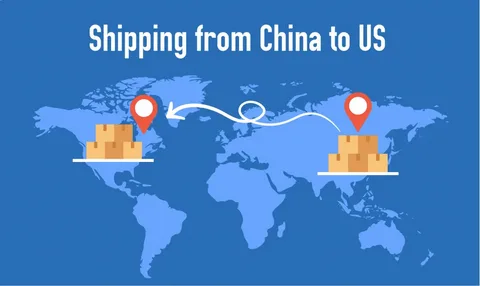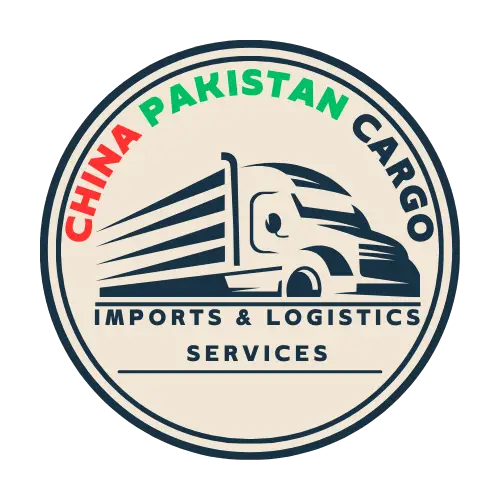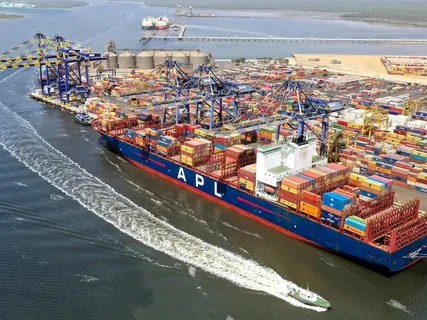In today’s fast-moving trade environment, the China–Pakistan shipping route has become one of the most important in South Asia. From electronics and machinery to garments and home accessories, thousands of Pakistani importers depend on reliable cargo solutions from China every day.
However, many first-time importers find the process confusing — questions like “Which shipping method is best?”, “How much will it cost?”, and “What about customs clearance?” are common.
This guide will help you understand how shipping from China to Pakistan works, which methods are available, and what to expect in terms of time, cost, and paperwork.

Overview: Why Shipping from China to Pakistan Matters
China is Pakistan’s largest trading partner. According to recent trade statistics, bilateral trade exceeds $12 billion annually, covering everything from electronics, furniture, and fabrics to machinery and raw materials.
The China-Pakistan Economic Corridor (CPEC) has further strengthened logistics networks through ports, railways, and road links. This connectivity allows businesses in Pakistan to import products from China quickly and affordably.
Whether you’re a small eCommerce seller or a large-scale importer, understanding the logistics options can help you save money, reduce delivery time, and ensure smooth customs clearance.
Shipping Methods from China to Pakistan
There are three main methods to transport goods between China and Pakistan:
a) Air Freight
Air freight China to Pakistan is the fastest shipping method — perfect for urgent, lightweight, or high-value goods.
Transit Time: 3–7 days
Best For: Electronics, fashion accessories, samples, or time-sensitive shipments
Main Airports: Guangzhou, Shenzhen, Shanghai → Karachi, Lahore, Islamabad
Pros:
- Fast delivery (within a week)
- High reliability and safety
- Real-time tracking available
Cons:
- More expensive than sea or road freight
- Limited by weight and size
b) Sea Freight
Sea freight from China to Pakistan is the most popular and cost-effective method for large shipments.
Transit Time: 20–35 days (port to port)
Main Routes: Shenzhen / Ningbo / Shanghai → Karachi Port / Port Qasim / Gwadar Port
Best For: Bulky cargo, wholesale goods, furniture, machinery, and textiles
Types of Sea Freight:
- FCL (Full Container Load): Ideal for large volumes. You get an entire container to yourself.
- LCL (Less than Container Load): Cost-effective option for smaller quantities where cargo is shared with other shipments.
Pros:
- Lowest cost per kilogram
- Suitable for all types of cargo
- Can handle heavy or oversized shipments
Cons:
- Slower than air freight
- Port congestion or customs delays may occur
c) Road Freight (via CPEC Route)
The China-Pakistan Economic Corridor (CPEC) now provides a direct overland cargo route connecting western China with Pakistan through the Khunjerab Pass.
Transit Time: 5–10 days
Main Route: Kashgar → Khunjerab → Gilgit → Islamabad → Karachi
Best For: General cargo, eCommerce shipments, mixed or consolidated loads
Pros:
- Faster than sea freight
- Lower cost than air freight
- Direct land connectivity reduces transshipment time
Cons:
- Limited seasonal operation (due to snow in winter months)
- Requires special road permits and border clearance
Understanding DDP (Door-to-Door Delivery Duty Paid)
If you want a stress-free solution, DDP (Delivered Duty Paid) shipping is the best option. Under DDP, your freight forwarder handles everything — pickup from your supplier in China, export customs, shipping, import clearance in Pakistan, and final delivery to your doorstep.
How DDP Works:
- Pickup from supplier or factory in China
- Export documentation and customs clearance
- Shipping via air, sea, or road
- Import customs clearance and tax payment in Pakistan
- Delivery to your door
Benefits:
- No need for import license
- All taxes and duties included in one invoice
- Time-saving and ideal for beginners
DDP is especially useful for Amazon sellers, online store owners, and new importers who don’t want to deal with paperwork or customs procedures.
Shipping Costs from China to Pakistan
Shipping costs depend on several factors, including cargo weight, volume, method, and delivery type. Below is a general estimate:
| Shipping Method | Estimated Transit Time | Average Cost (Per Kg) | Best For |
| Air Freight | 3–7 days | $5–$10 | Urgent or light cargo |
| Sea Freight (LCL) | 25–35 days | $0.5–$1 | Small to medium volume |
| Sea Freight (FCL) | 25–30 days | $1000–$2500 per container | Large shipments |
| Road Freight (CPEC) | 5–10 days | $2–$4 | General cargo / mixed goods |
| DDP Door-to-Door | 7–25 days | All-inclusive | Beginners / eCommerce |
Note: Prices vary depending on the season, fuel rates, and customs duties.
Required Documents for Shipping from China to Pakistan
Proper documentation ensures smooth customs clearance at both ends. Here’s what’s typically required:
- Commercial Invoice & Packing List
- Export Customs Declaration (China)
- Bill of Lading / Air Waybill
- Certificate of Origin (if applicable)
- Import Declaration & Tax Receipts (Pakistan)
- Delivery Confirmation (Proof of Delivery)
If you’re using a DDP shipping service, your freight partner handles all these documents on your behalf.
Customs Clearance in Pakistan
All goods imported into Pakistan must go through customs clearance, where the authorities verify shipment value, classification, and duty.
Import Duties and Taxes:
Duties vary depending on your product’s HS Code (Harmonized System Code). Common charges include:
- Customs Duty: 0%–25% (varies by product)
- Sales Tax (GST): Usually 17%
- Income Tax (Withholding): 5%–10%
- Additional Duty / Regulatory Duty: Applied to certain goods
Pro Tip:
To avoid unexpected costs, always ask your supplier or freight forwarder for a landed cost quote that includes customs duties, VAT, and delivery fees.
Common Shipping Terms (Incoterms) Explained
When discussing shipping with your Chinese supplier, you’ll come across several Incoterms — these define who is responsible for what.
| Term | Responsibility | Description |
| EXW (Ex Works) | Buyer | You handle everything from the factory onward |
| FOB (Free on Board) | Seller + Buyer | Seller handles up to Chinese port; buyer handles shipping onward |
| CIF (Cost, Insurance & Freight) | Seller | Seller pays shipping and insurance until Pakistani port |
| DDP (Delivered Duty Paid) | Seller / Forwarder | All-inclusive service — no extra work for buyer |
DDP is the most convenient for importers who prefer door-to-door service.
Shipping Tips to Reduce Delays and Costs
Shipping from China to Pakistan can be smooth if you plan ahead. Here are expert tips:
- Consolidate Shipments: Combine multiple orders into one container to save cost.
- Check Supplier Readiness: Ensure goods are well-packed and labeled before pickup.
- Use Reliable Freight Forwarders: Choose a company experienced in China–Pakistan logistics.
- Track Shipments: Always monitor your cargo status for timely updates.
- Prepare Correct HS Codes: Prevent customs delays or revaluation issues.
- Avoid Peak Seasons: Rates rise during Chinese New Year or holiday rushes.
Shipping Routes and Major Hubs
In China:
- Guangzhou, Shenzhen: Ideal for electronics and consumer goods
- Yiwu: Popular for wholesale and small items
- Shanghai, Ningbo: Major sea ports for large shipments
In Pakistan:
- Karachi Port / Port Qasim: Main seaports for container cargo
- Gwadar Port: Growing hub under CPEC
- Islamabad & Lahore Airports: Air cargo entry points
- Sust Dry Port (Gilgit-Baltistan): Key road freight terminal under CPEC
Why Choose a Professional Cargo Partner
Shipping between China and Pakistan involves multiple steps — from export paperwork to customs clearance and delivery. Partnering with a professional freight forwarder ensures you avoid mistakes, save time, and reduce hidden costs.
Look for a logistics provider that offers:
- Transparent pricing
- DDP and DDU options
- Dedicated customer support
- Experience with China–Pakistan trade routes
Final Thoughts
Shipping from China to Pakistan doesn’t have to be complicated. With the right knowledge and logistics partner, you can import goods safely, on time, and at a reasonable cost.
Whether you’re sending small parcels or full containers, understanding shipping methods, documentation, and customs procedures helps you make smarter business decisions.
By choosing Door-to-Door (DDP) cargo services, you eliminate most of the hassles — your shipment arrives ready for sale, without you worrying about clearance or duty payments.
In short, success in importing from China to Pakistan comes down to one thing: planning smartly and partnering wisely.
Frequently Asked Questions (FAQ)
What’s the cheapest shipping method from China to Pakistan?
Sea freight (LCL or FCL) is the most economical option, especially for large or heavy cargo.
How long does it take to ship from China to Pakistan?
- Air freight: 3–7 days
- Road freight: 5–10 days
- Sea freight: 20–35 days
3. Do I need an import license?
If you use a DDP service, no import license is required — your forwarder manages everything.
4. What are restricted or prohibited items?
Avoid shipping weapons, flammable materials, counterfeit goods, or restricted pharmaceuticals.
5. Can I track my cargo?
Yes, most professional logistics companies offer online tracking or WhatsApp updates.

